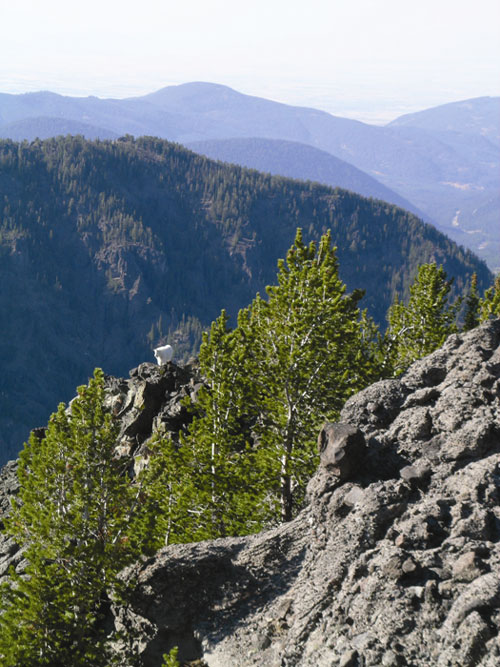Goat country is outrageously high, totally vertical, bolder-strewn, windblown, and often encased in ice and snow. Few adventurers hike into goat terrain, much less attempt to down the trophy with an arrow. Enter Montana native Jesse Nelson, a fanatical bowhunter who began applying for goat tags at age 12 and, 20 years later, believed he was due.
Nelson, who hunts 10 months each year, had spent a mid-May weekend stalking in the mountains above Bozeman when he injured his knee wh ile chasing a bear. Not one to cause a fuss, he finished the hunt, ignoring a 2-inch gash and “something” hanging from the wound—the bursa. Knee surgery followed immediately, a medical procedure that included a full-length leg cast. Two days later, Nelson hobbled to the mailbox where he found his long-awaited tag.
ile chasing a bear. Not one to cause a fuss, he finished the hunt, ignoring a 2-inch gash and “something” hanging from the wound—the bursa. Knee surgery followed immediately, a medical procedure that included a full-length leg cast. Two days later, Nelson hobbled to the mailbox where he found his long-awaited tag.
Plan To Succeed
The will to prepare to succeed may be more important than the will to succeed, and Jesse Nelson personified putting the preparation pedal to the metal from Day 1.
“I had the cast on for a month, and the first thing I did was buy every map of the entire hunting unit,” says Nelson. “I called everyone who knew anything about goat hunting and made a list, including their friends.”
Later, the knee was recast so that Nelson could drive, but still not work. He scouted a variety of ranch houses with likely goat access and asked for permission. Picture a man on crutches at your front door asking permission to hunt mountain goats. Who could say “No”? Ironically, numerous landowners granted permission, but few of those leads paid off.
Next, Nelson drove to many of the map locations with promising goat populations and glassed the cliffs extensively. At one point, he borrowed a boat, cruised to the center of a lake, propped up his leg and glassed cliffs that could not be seen from the road.
Montana’s mountain goat units are large, and Nelson soon learned the he had made a mistake. “I wished I had researched the kill statistics from my unit before applying,” he remembers. “No billy had been harvested by hunters with horns 10 inches or larger. Apparently, the genetics were just average.”
Weather and access are also big factors in assessing promising mountain goat country. “Some of the places with good goat populations would be snowed out by hunting seasons, and other were impossible to approach with a bow,” says Nelson, who made 21 scouting trips and documented 298 sightings. “That’s a lot more animals than Fish & Game estimated, but I took good notes and am confident there were few duplicate sightings.”
The cast finally came off by July 4, and he and his wife, Jody, hiked into the high country. Mrs. Nelson is an avid bowhunter and often accompanied her husband into the field. A 72 mm Leica spotting scope—a powerful glass with a 20X lens and a 20-60X zoom—was Nelson’s other companion. “The spotting scope was invaluable in judging horn size,” Nelson says. “Scoring mountain goats is very precise work, and getting within 500 yards is a must.”
Opening Day
After waiting 20 years, scouting 21 times, and glassing nearly 300 animals, when the goat season finally opened September 5, Nelson went elk hunting. Montana mountain billies develop their full winter hair and pantaloon physique the last week of September, and Nelson wanted to hunt his quarry in prime condition.
An electrician by trade, Nelson planned his work schedule for maximum flexibility. September 24 was his first hunting trip, and despite a significant snowstorm, Nelson left home at 4 a.m., drove 20 miles, and hiked two hours before he could begin looking. To reach previous goat sightings took a three-hour climb through a canyon with no trails.
Nelson worked his way partially up a large avalanche shoot, moving as best as he could in waist-deep snow. “By noon, I was still two hours away from goat country and had to turn back,” he says with a hint of disappointment.
Nelson’s next hunting opportunity occurred in early October when hunting buddy Jason Tounsley accompanied him. The weather was warming, and Nelson believed he could reach a basin that usually held a large billy. The two men began at daylight, climbed for hours through heavy snow, but soon reached an elevation where the snow crusted, making climbing much easier.
By 9 a.m. the duo entered a huge horseshoe canyon and spotted a goat on the east wall. The goat was unapproachable at that point, so the men decided to scout the west rim and work toward the goat’s location at the end of the day. The ridge topped out at 10,000 feet where the hunters came upon four bighorn rams—quite a sight yet not the game they wanted. To reach the summit they had to walk along a cliffside trail that varied from two feet wide to virtually nothing—typical goat country. Reaching a rocky point, they stopped for a breather and suddenly noticed two white spots below them.
Next: High Mountain Stalk






